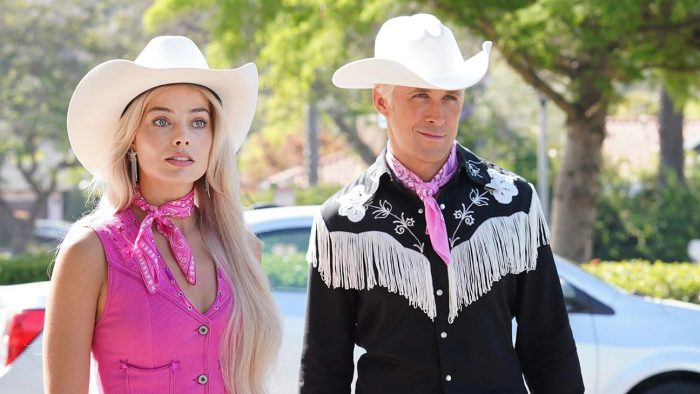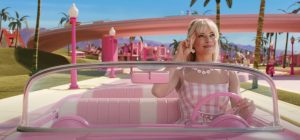Movie Review: ‘Barbie’ movie is pink, plastic and fantastic

Reviewed by Jeffrey Sanzel
What can you say about someone who has had over two hundred careers—fashion editor, science teacher, paramedic, paratrooper, Canadian Mountie, aircraft engineer—but was quoted as saying, “Math is tough?” While she beat Neil Armstrong to the moon, she encouraged her followers to “Get your sparkle on—show the world where you belong.”
Featured from toy shelves to The Nutcracker (to The Magic of Pegasus 3-D), Barbie—full name Barbara Millicent Roberts—first appeared in March 1959. The eleven-inch plastic figure was the brainchild of Ruth Handler (Mattel, Inc. co-founder, with husband, Elliot). Inspired by the German Bild Lilli doll, the first Barbie sold for $3. Today, Barbie is a multi-billion-dollar industry.
Barbie’s world includes her on-again-off-again boyfriend Ken, best friend Midge, and sister Skipper. The first celebrity Barbie was Twiggy (1967). Barbie first ran for president in 1992 and has been on the campaign trail at least seven times since. She will continue to evolve and be reinvented. But as busy as she is, Barbie has now made time for a feature film.
Director Greta Gerwig (Lady Bird, Little Women) reteams with Frances Ha screenwriter Noah Baumbach (The Squid and the Whale, Marriage Story, Margot at the Wedding) to direct “big screen” Barbie. They have written a fascinating societal exploration, presented through the prism of the alternate world, Barbie Land. Barbie is no theme park ride or action toy translated to a mass market money grab. The film is a serious meditation on gender roles and expectations. It takes on multiple overlapping themes—perhaps too many to answer—and resonates long after its brisk two-hour running time.

Barbie deals with a tear in the separation of Barbie Land and the real world, a rip connected to Barbie’s doubts about her perfect existence. She leaves the female/Barbie-dominated universe to learn that women have not achieved the positions of strength they have in her native existence. Initially, the comedic conflict sparks from the clash of the two planes. Still, the bigger issue arises from Ken’s awareness of the disproportionate power allotted to men outside Barbie Land. (In Barbie Land, the Kens are relegated to a peripheral existence, not holding the key positions taken by the Barbies.) Ken’s epiphany causes Barbie Land to devolve into a world of toxic masculinity dominated by the Kens. The host of mindless bros’ tenuous grasp turns the idyllic utopia into an almost hellish frat-scape, Kendom Land. The fact that Ken somehow connects patriarchy to horses speaks volumes.
The resolution strangely errs on the side of hijinks, with the Barbies righting their world through a subterfuge that plays on Kens’ easily flattered egos. The commentary is strong but subsumes the message of self-awareness and empowerment. They fool the doltish Kens rather than directly engage them. However, in the end, the Kens gain a modicum of self-awareness.
Barbie manages to be comedy, spoof, satire, and message movie, sometimes in turn, other times simultaneously. From its 2001: A Space Odyssey opening to its exquisitely conceived Barbie Land that is both vibrantly two- and three-dimensional, Barbie is a delight, with visual jokes, hilarious asides, and social commentary.
Margot Robbie’s in all ways flawless Barbie proves the actor’s exceptional skills and depth. She manifests a true living doll but allows for both growth and arc, never missing a beat or a laugh. Ryan Gosling makes the ideal foil, as the mostly clueless Ken, coming to a misplaced awareness. The supporting Barbies are effective on different levels, as are the coterie of Kens.
America Ferrera’s real-world Gloria has the most memorable moment in the film—a speech about the double standard women face daily. Her passion and laser focus give weight without weighing down the significance. Ariana Greenblatt, as her daughter, Sasha, neatly represents today’s generation of detached teens searching for connection. Michael Cera’s sad sack Allan is subtly hysterical.
Rhea Pearlman offers the luminous, not-so-spectral spirit of Barbie creator Ruth Handler. In her two scenes, she manages to be heartbreakingly human and otherworldly wise. She speaks as the head and heart of possibility, which was her inspiration in creating the doll. She is somehow Dumbledore to Barbie’s Harry.
The film’s major misfire is the comedic Mattel corporate board, headed by Will Ferrell, doing Will Ferrell at his most Will Ferrell. The painfully predictable slapstick seems forced in an otherwise sharp and meditative story.
*Reviewing is the definition of subjective. I left unsure of exactly how I felt about what I had witnessed. I also knew that I was not its true demographic.
Curious, I engaged with people exiting the film and reached out to others over the next few days. These ranged from adult mothers and daughters with complementary opinions to viewers in their twenties and thirties. Three slightly dazed mothers with a half dozen girls under age eight contemplated how much their young charges had—or had not—understood.
While a few attendees were mildly disappointed, the consensus was that Barbie was an effective and affecting film. Older viewers seem most linked by the nostalgia, reflecting bittersweetly on childhood hours. However, recurring comments tended towards empowerment, identity, and reflection of girlhood/womanhood. The film seriously considered the day-to-day struggles of being female and cultural over-sexualization. But Barbie also symbolizes the ability to change, hearkening to her creation as representing myriad possibilities. Many were deeply moved by the montage of women throughout the twentieth and twenty-first centuries; almost all cited Gloria’s monologue as a high point. The most common refrain was, “I felt seen.”
Ultimately, Barbie transcends. As a work and work of art, it accomplished something extraordinary, something “more than.” It has let its audience “feel seen.” And that alone makes Barbie exceptional.
Rated PG-13, the film is now playing in local theaters.






